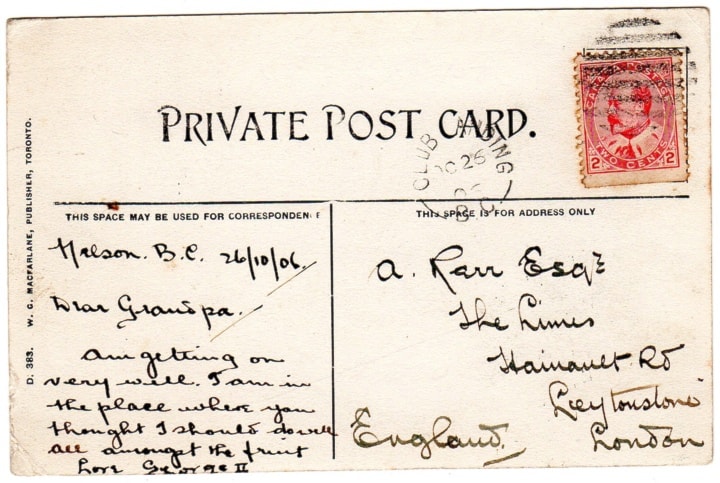Thirty-sixth in a semi-alphabetical series on West Kootenay/Boundary place names
In June 1897, Joseph Presley Clubb of Missouri (1850-1924) filed a pre-emption on the West Arm of Kootenay Lake, about a mile downstream of today’s Longbeach.
His quarter section became known as Clubb Landing. The earliest known use of the name is in the Nelson Daily Miner of January 6, 1900. According to Kootenay Outlet Reflections, after proving up his pre-emption, Clubb sold it to Hong Ming Chong of Nelson and moved to Queens Bay and then Boswell.
Chong continued to clear the land, planting strawberries among the rocks and stumps, and in turn sold to Henry Crozier Smith and H.H. Sewell.
Clubb Landing was often misspelled Club Landing, and that’s what the postal authorities called it when an office opened on July 1, 1906. It closed after postmaster John P. Woodward resigned on March 7, 1907 and departed for Arizona with Sewell to grow alfalfa.
Henry Smith, however, stayed, and coaxed brother Burrard Archibald Smith out from England to join him. The Smiths built a log float in front of their house which was dubbed Smith’s Landing on CPR timetables. The Smith family remains connected to the area to this day: Burrard’s son Eric moved to Nelson three years ago with wife Greta, but their family still has five acres at Longbeach.
Joe Clubb died in Kamloops and was buried there. His landing is not well remembered.
Coltern
This ghost town northeast of Greenwood was originally and otherwise known as Oro Dinero — Spanish for “gold money” — after a mine of the same name. It was also called Oro Denoro, Oro Denora, and just Denoro,
The mining camp dated to late 1897 but the townsite was first mentioned in the Cascade Record of February 10, 1900: “The new towns of Oro Denoro and Summit City will soon have telephone and post offices.”
A report on the post office application filed that month stated the rival owners of the adjacent townsites were trying to combine them. Postal inspector W.H. Dorman said if that was accomplished, he would recommend approval, “but at present the post office is wanted more to boom a townsite than from actual necessity.”
The Denoro post office didn’t open until May 1, 1908. It closed September 30, 1910 and then reopened as Coltern on October 1, 1917 only to close again August 31, 1919. The origin of Coltern is a mystery but it appears to have been adopted when a school opened in 1916.
Anna Moore, a student in 1919, recalled in Alice Glanville’s Schools of the Boundary: “I did start at Coltern school but the town was called Oro Denora. The settlement depended on the Emma mine. A branch of the CPR ran from Eholt to Oro Denora and the station was also called Coltern.”
One other odd note: in 1910, the civic directory listed Denoro’s J.A. McMillan as a “lighthouse keeper.”
Previous installments in this series
Applegrove, Appleby, and Appledale revisited
Bakers, Birds, and Bosun Landing
Bannock City, Basin City, and Bear Lake City
Boswell, Bosworth, Boulder Mill, and Broadwater
Brooklyn, Brouse, and Burnt Flat
Camborne, Cariboo City, and Carrolls Landing
Carmi, Cedar Point, Circle City, and Clark’s Camp
Carson, Carstens, and Cascade City
